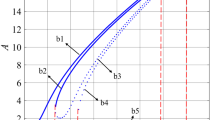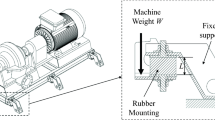Abstract
This paper presents a quantitative investigation on the level of vibration force and power flow transmission between linearly coupled nonlinear oscillators. Both analytical and numerical methods are employed for systematic examinations of the vibration transmission associated with hardening, softening and double-well potential stiffness nonlinearities in the oscillators. The method of averaging is employed to obtain analytical formulations of the steady-state frequency-response relationship. Time-averaged power flow variables are formulated and used to quantify vibration input, dissipation and transmission levels associated with both periodic and chaotic responses. It is shown that the stiffness nonlinearities have significant effects on vibration transmission levels near resonance frequencies and in the low-frequency range. It is also shown that when both oscillators are of double-well potential stiffness, the system may exhibit chaotic motions with higher levels of vibration transmission between the oscillators as compared to the corresponding first-order analytical approximations, because of large super-harmonic components in the response. It is found that there may be multiple possible levels of vibration transmission due to co-existing periodic or chaotic responses. It is shown that when comparing the vibration transmission levels of the co-existing stable responses, the use of time-averaged transmitted power and force transmissibility may lead to different evaluation outcomes. These findings provide a better understanding of the effects of stiffness nonlinearities on the vibration transmission which may be maximized or suppressed based on specific design objectives for enhanced dynamic performance.














Similar content being viewed by others
References
Goyder HGD, White RG (1980) Vibration power flow from machines into built-up structures. J Sound Vib 68:59–117
Langley RS (1990) Analysis of power flow in beams and frameworks using the direct-dynamic stiffness method. J Sound Vib 136:439–452
Cuschieri JM (1990) Structural power-flow analysis using a mobility approach of an L-shaped plate. J Acoust Soc Am 87:1159–1165
Langley RS (1992) A wave intensity technique for the analysis of high frequency vibrations. J Sound Vib 159:483–502
Mace BR, Shorter PJ (2000) Energy flow models from finite element analysis. J Sound Vib 233:369–389
Xing JT, Price WG (1999) A power-flow analysis based on continuum dynamics. Proc R Soc A 455:401–436
Xiong YP, Xing JT, Price WG (2005) A power flow mode theory based on a system’s damping distribution and power flow design approaches. Proc R Soc A 461:3381–3411
Xiong YP, Xing JT, Price WG (2001) Power flow analysis of complex coupled systems by progressive approaches. J Sound Vib 239:275–295
Xiong YP, Xing JT, Price WG (2003) A general linear mathematical model of power flow analysis and control for integrated structure–control systems. J Sound Vib 267:301–334
Ibrahim RA (2008) Recent advances in nonlinear passive vibration isolators. J Sound Vib 314:371–452
Zulli D, Luongo A (2016) Control of Primary and subharmonic resonances of a Duffing oscillator via nonlinear–linear energy sink. Int J Nonlinear Mech 80:170–182
Yang J, Xiong YP, Xing JT (2013) Dynamics and power flow behaviour of a nonlinear vibration isolation system with a negative stiffness mechanism. J Sound Vib 332:167–183
Habib G, Detroux T, Viguie R, Kerschen G (2015) Nonlinear generalization of Den Hartog’s equal-peak method. Mech Syst Signal Process 52–53:17–28
Royston TJ, Singh R (1996) Optimization of passive and active non-linear vibration mounting systems based on vibratory power transmission. J Sound Vib 194:295–316
Vakakis AF, Gendelman OV, Bergman LA, McFarland DM, Kerschen G, Lee YS (2008) Nonlinear targeted energy transfer in mechanical and structural systems. Springer, New York
Dekemele K, De Keyser R, Loccufier M (2018) Performance measures for targeted energy transfer and resonance capture cascading in nonlinear energy sinks. Nonlinear Dyn 93:259–284
Xiong YP, Xing JT, Price WG (2005) Interactive power flow characteristics of an integrated equipment-nonlinear isolator-travelling flexible ship excited by sea waves. J Sound Vib 287:245–276
Yang J, Xiong YP, Xing JT (2014) Nonlinear power flow analysis of the Duffing oscillator. Mech Syst Signal Process 45:563–578
Yang J, Xiong YP, Xing JT (2016) Vibration power flow and force transmission behaviour of a nonlinear isolator mounted on a nonlinear base. Int J Mech Sci 115–116:238–252
Yang J, Xiong YP, Xing JT (2015) Power flow behaviour and dynamic performance of a nonlinear vibration absorber coupled to a nonlinear oscillator. Nonlinear Dyn 80:1063–1079
Yang J, Shi BY, Rudd C (2018) On vibration transmission between interactive oscillators with nonlinear coupling interface. Int J Mech Sci 137:238–251
Shi BY, Yang J, Rudd C (2019) On vibration transmission in oscillating systems incorporating bilinear stiffness and damping. Int J Mech Sci 150:458–470
Nayfeh AH, Mook DT (1979) Nonlinear oscillations. Willey, New York
Press WH, Flannery BP, Teukolsky SA, Vetterling WT (1992) Numerical recipes: the art of scientific computing. Cambridge University Press, Cambridge
Wolf A, Swift JB, Swinney HL, Vastano JA (1985) Determining Lyapunov exponents from a time series. Phys D 16(3):285–317
Acknowledgements
This work was supported by National Natural Science Foundation of China (Grant No. 51605233).
Author information
Authors and Affiliations
Corresponding author
Ethics declarations
Conflict of interest
The authors declare that they have no conflict of interest.
Rights and permissions
About this article
Cite this article
Shi, B., Yang, J. Quantification of vibration force and power flow transmission between coupled nonlinear oscillators. Int. J. Dynam. Control 8, 418–435 (2020). https://doi.org/10.1007/s40435-019-00560-7
Received:
Revised:
Accepted:
Published:
Issue Date:
DOI: https://doi.org/10.1007/s40435-019-00560-7




